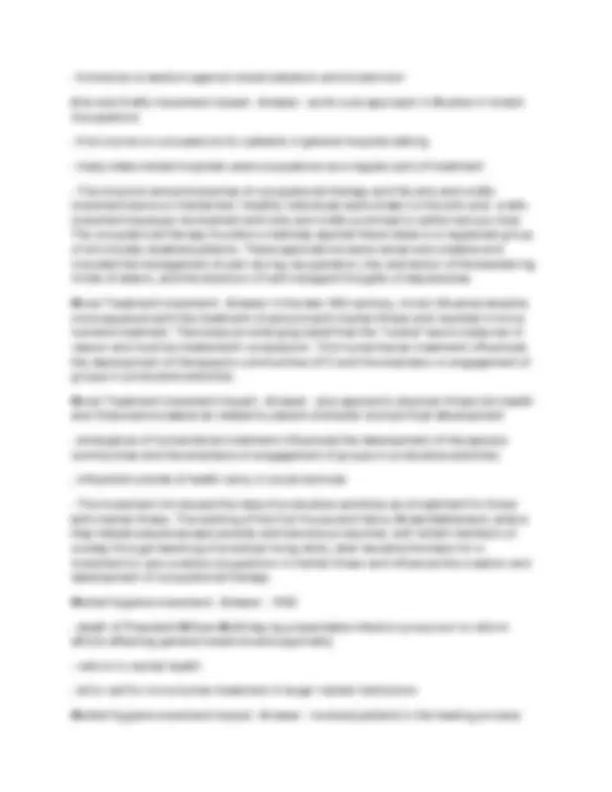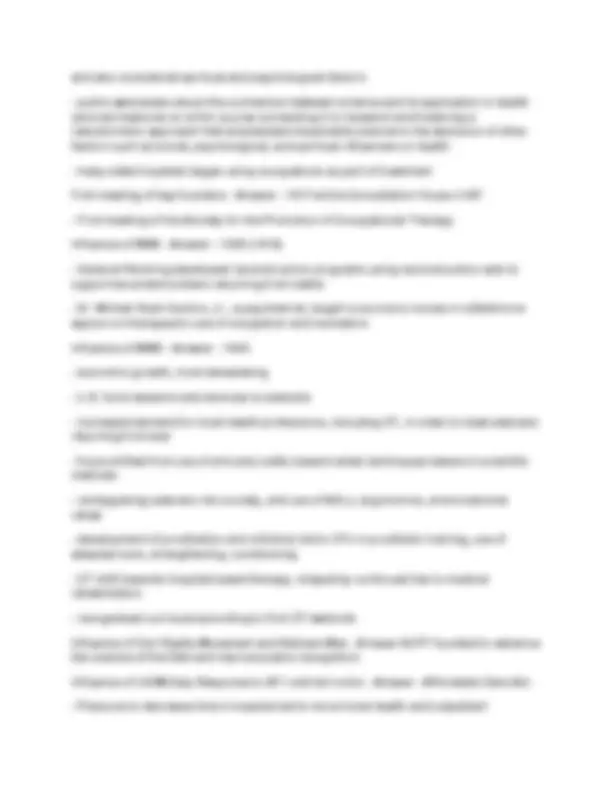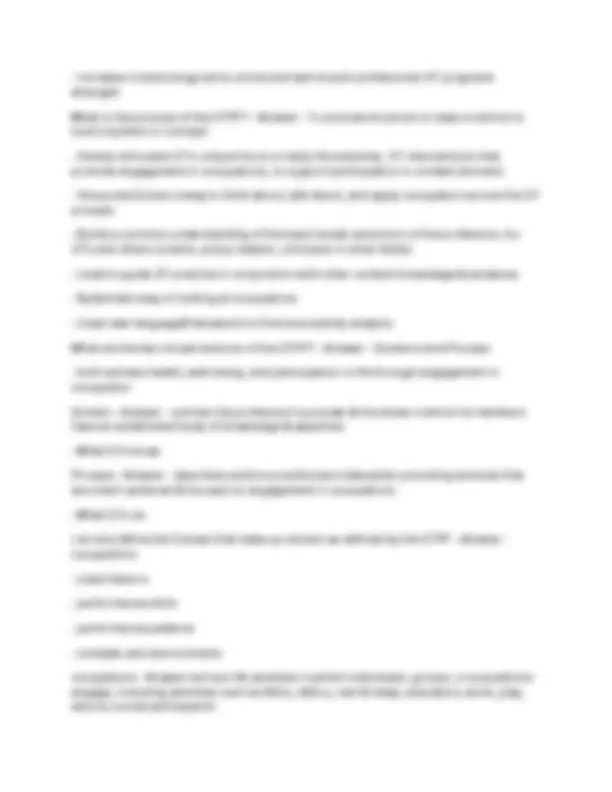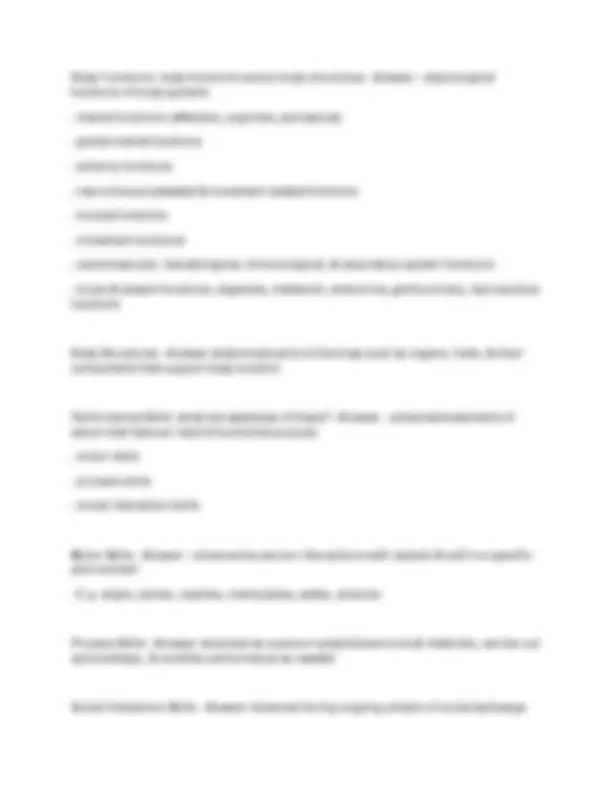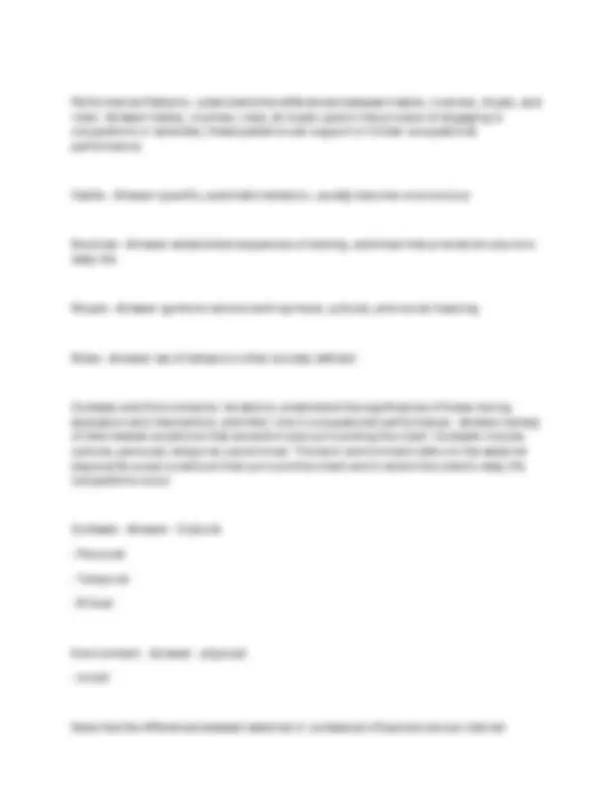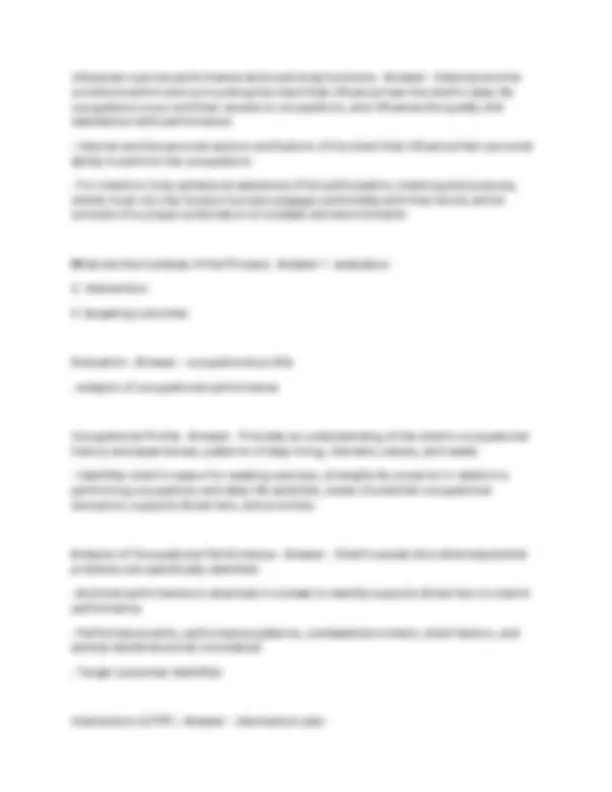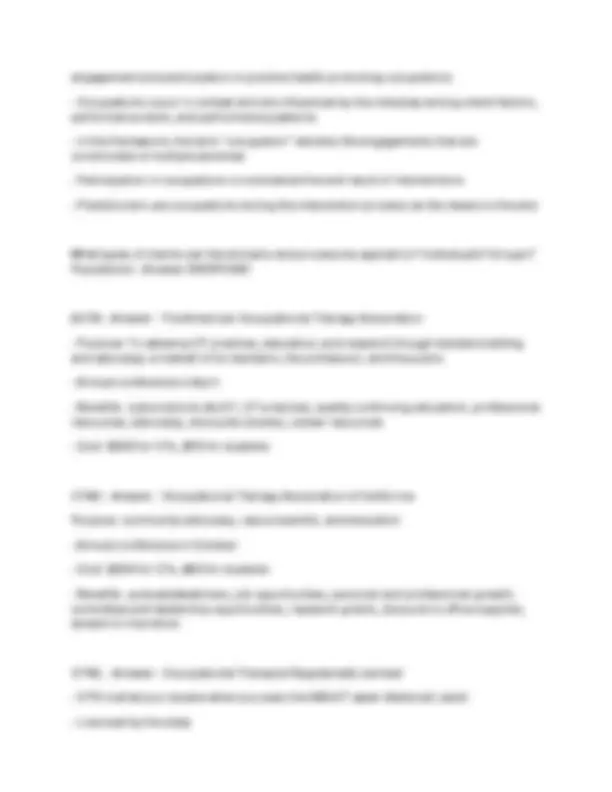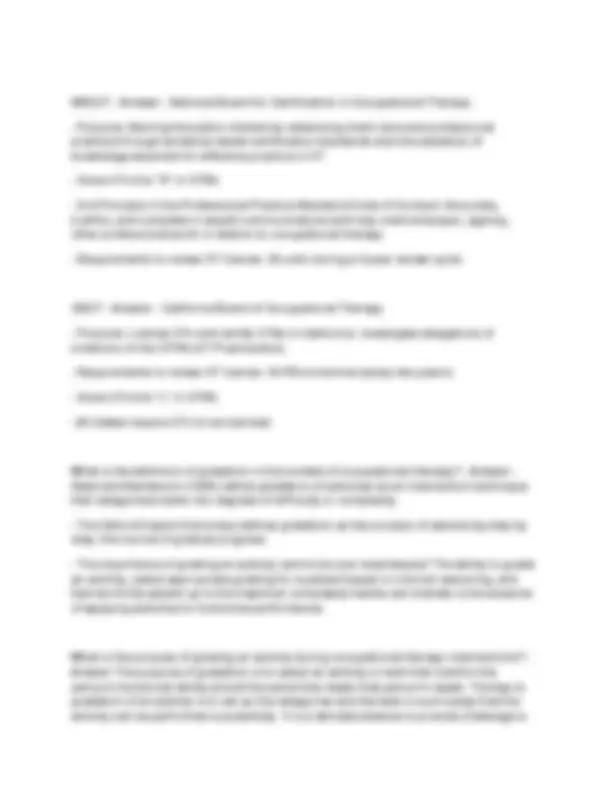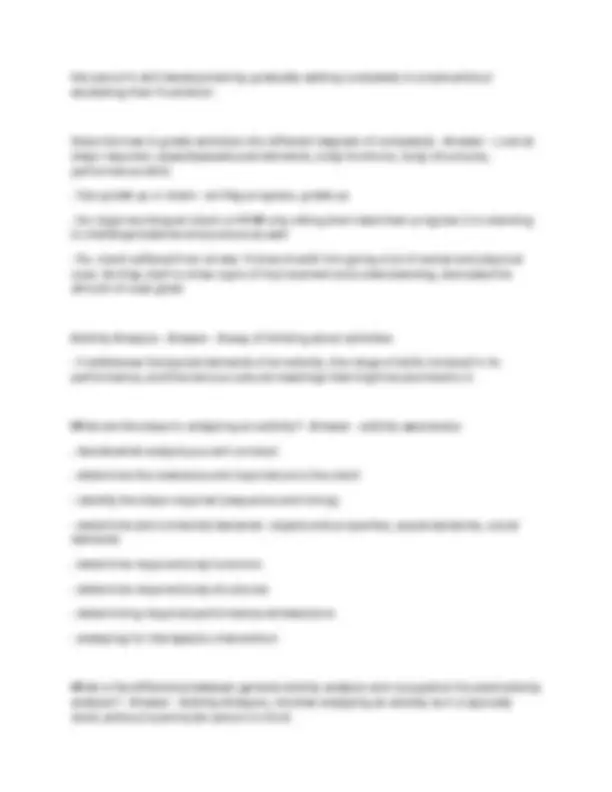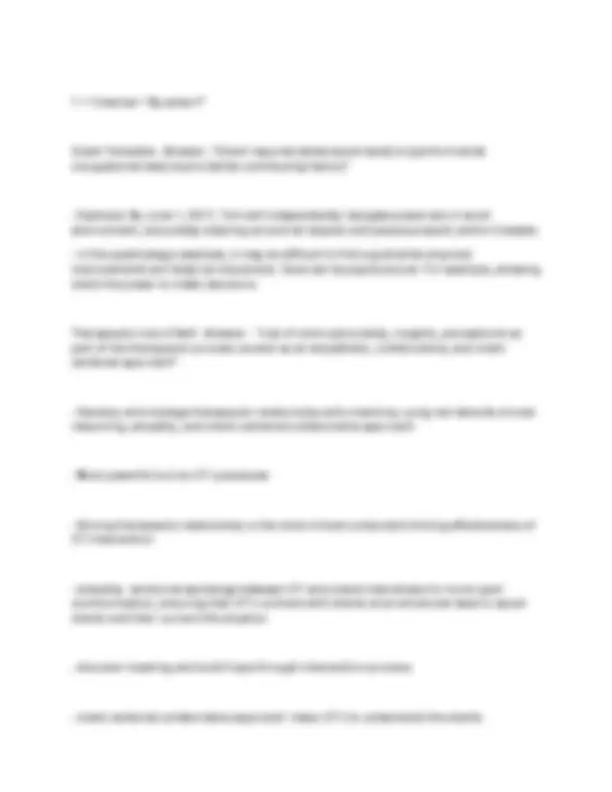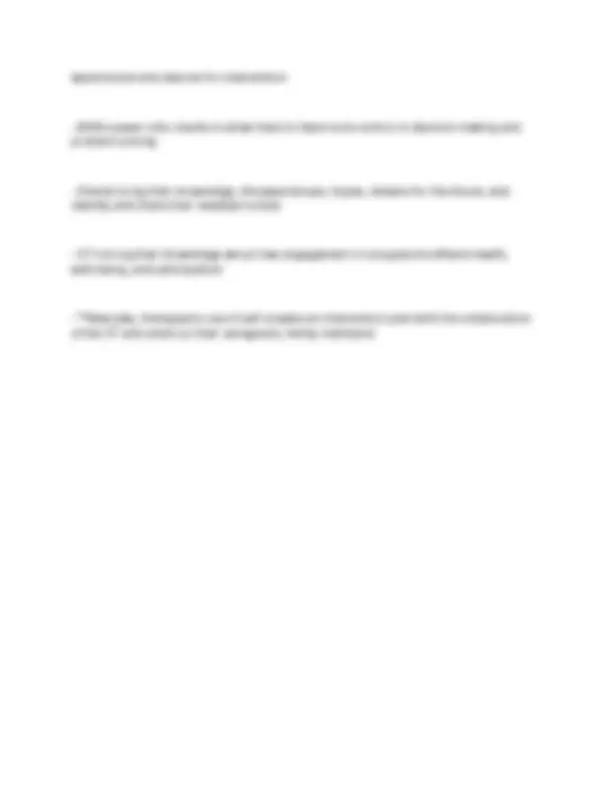Download OT 5012 Foundations Midterm 1 Exam Study Guide and more Exams Advanced Education in PDF only on Docsity!
OT 5012 Foundations Midterm 1
Exam Study Guide
Occupational Therapy - Answer - Therapeutic use of everyday life activities (occupations) with individuals or groups for the purpose of enhancing or enabling participation in roles, habits, and routines in home, school, workplace, community, and other settings
- Activities of everyday life, named, organized, and given value and meaning by an individual and a culture. Occupation is everything people do to occupy themselves, including looking after the themselves, enjoying life, and contributing to the social & economic fabric of their communities
- Art & science of helping people do the day to day activities that are important & meaningful to their health & well-being through engaging in valued occupations Client-centered practice - Answer -Approach to service that incorporates respect for and partnership with clients as active participants in the therapy process. This approach emphasizes clients' knowledge and experience, strengths, capacity for choice, and overall autonomy
- Focus on the client
- Focus on the meaning of the activity
- Relationship centered Occupations vs. activities - Answer - All that people need, want, or obliged to do, what it means to them, and its ever potential as an agent of health and an agent of change
- Active process of living; from the beginning to the end of life, our occupations are all the active processes of looking after ourselves & others, enjoying life, and being socially & economically productive over the lifespan in various contexts
- Specific chunks of activity within the ongoing stream of human behavior which are named in the lexicon of the culture. These daily pursuits are self-initiated, goal-directed (purposeful), and socially sanctioned.
- Everything people do to occupy themselves including looking after themselves (self-care), enjoying themselves (leisure), and contributing to the social & economic fabric of their communities (productivity).
- Are goal oriented
- Have meaning for the person(s) choosing them
- Occur within a specific context
- Occupations are more than just activities. They are the activities that give lives meaning.
- Occupations are personalized activities that hold personal meaning & requirements for a particular person/group
- It's MORE COMPLEX than an activity
- E.g. Activity = making sandwich vs. Occupation = Lisa making a sandwich for her daughter at home How do occupational therapists use occupations in practice? - Answer - Occupations= the foundation to our profession
- Use occupations (and activities) not only as our goals, but also as the means by which we meet those goals; thus, occupations and activities are our "tools."
- OTs use occupations or meaningful activities as interventions because we understand the greater benefit of using activities that are meaningful vs other techniques/approaches
- Occupation can serve as both a means & ends, both a therapeutic medium and an outcome
- Means = therapeutic medium (what we use to support therapy)
- Ends = outcome
- Engaged in process to understand what the end (outcome) needs to be
- OTs use occupations for evaluation and intervention Evaluation - Answer Occupational therapists begin with an overt focus on understanding the client's most relevant occupations and how satisfied the client is with how they are performed. Occupational therapists observe occupational performance ideally in the natural context, or as closely simulated to where, when and how the occupation typically occurs. Intervention - Answer Use relevant occupations as their primary means to achieve goals related to performance. This may include using occupations to establish or remediate client skills and body functions, promote health, or prevent dysfunction. While participating in meaningful occupations, specific tasks might be modified to better match the person's abilities, or aspects of the environment might be adapted for improved occupational performance and participation. Arts and Crafts movement - Answer - 1900: Emmanualism
- work-based approach for neurasthenia
- work cure
and also considered spiritual and psychological factors
- public awareness about the connection between science and its application in health care set medicine on a firm course connecting it to research and fostering a reductionistic approach that emphasized observable science to the exclusion of other factors such as social, psychological, and spiritual influences on health
- many state hospitals began using occupations as part of treatment First meeting of key founders - Answer - 1917 at the Consultation House in NY
- First meeting of the Society for the Promotion of Occupational Therapy Influence of WWI - Answer - 1920 (1918)
- General Pershing developed reconstruction programs using reconstruction aids to support wounded soldiers returning from battle
- Dr. William Rush Dunton, Jr., a psychiatrist, taught a course to nurses in a Baltimore asylum on therapeutic use of occupation and recreation Influence of WWII - Answer - 1940
- economic growth, most devestating
- U.S. fund research and services to veterans
- increased demand for most health professions, including OT, in order to treat veterans returning from war
- focus shifted from use of arts and crafts toward rehab techniques based on scientific methods
- reintegrating veterans into society, and use of ADLs, ergonomics, and vocational rehab
- development of prosthetics and orthotics led to OTs in prosthetic training, use of adapted tools, strengthening, conditioning
- OT shift towards hospital-based therapy; shaped by continued ties to medical rehabilitation
- reorganized curricula according to first OT textbook Influence of Civil Rights Movement and Vietnam War - Answer AOTF founded to advance the science of the field and improve public recognition Influence of US Military Response to 9/11 and terrorism - Answer - Affordable Care Act
- Pressure to decrease time in hospital led to more home health and outpatient
- Increase in technology led to online and hybrid post professional OT programs emerged What is the purpose of the OTPF? - Answer - To provide structure or base on which to build a system or concept
- Clearly articulate OT's unique focus on daily life activities, OT interventions that promote engagement in occupations, to support participation in context (domain)
- Give practitioners a way to think about, talk about, and apply occupation across the OT process
- Builds a common understanding of the basic tenets and vision of the profession, for OTs and others (clients, policy makers, clinicians in other fields)
- Used to guide OT practice in conjunction with other content knowledge & evidence
- Systematic way of looking at occupations
- Used new language/framework to fine tune activity analysis What are the two broad sections of the OTPF? - Answer - Domains and Process
- both achieve health, well-being, and participation in life through engagement in occupation Domain - Answer - outlines the profession's purview & the areas in which its members have an established body of knowledge & expertise
- What OTs know Process - Answer - describes actions practitioners take when providing services that are client centered & focused on engagement in occupations
- What OTs do List and define the 5 areas that make up domain as defined by the OTPF - Answer - occupations
- client factors
- performance skills
- performance patterns
- contexts and environments occupations - Answer various life activities in which individuals, groups, or populations engage, including activities such as ADLs, iADLs, rest & sleep, education, work, play, leisure, social participation
- Sleep Preparation
- Sleep Participation
Education - Answer activities needed for learning & participating in the educational environment
Work - Answer labor or exertion; to make/construct objects; to organize, plan, or evaluate services or processes of living or governing
Play - Answer any spontaneous or organized activity that provides enjoyment, entertainment, amusement, or diversion
Leisure - Answer any spontaneous or organized activity that provides enjoyment, entertainment, amusement, or diversion
Social Participation - Answer interweaving of occupations to support desired engagement in community and family activities as well as involving peers & friends
Client factors - Answer values, beliefs, & spirituality; body functions; and body structures that reside within the client that influence the client's performance in occupations
Values - Answer acquired beliefs & commitments derived from culture about what is good, right, and important to do
beliefs - Answer cognitive content held as true by or about the client
Spirituality - Answer aspect of humanity that refers to the way individuals seek & express meaning and purpose and the way they experience their connectedness to the moment, to self, to others, to nature, and to the significant or sacred
Body Functions: body functions versus body structures - Answer - physiological functions of body systems
- mental functions (affective, cognitive, perceptual)
- global mental functions
- sensory functions
- neuromusculoskeletal & movement related functions
- muscle functions
- movement functions
- cardiovascular, hematological, immunological, & respiratory system functions
- voice & speech functions, digestive, metabolic, endocrine, genitourinary, reproductive functions
Body Structures - Answer anatomical parts of the body such as organs, limbs, & their components that support body function
Performance Skills: what are examples of these? - Answer - observable elements of action that have an implicit functional purpose
- motor skills
- process skills
- social interaction skills
Motor Skills - Answer - observed as person interactions with objects & self in a specific environment
- E.g. aligns, bends, reaches, manipulates, walks, endures
Process Skills - Answer observed as a person selects/uses tools & materials, carries out actions/steps, & modifies performance as needed
Social Interaction Skills - Answer observed during ongoing stream of social exchange
influences such as performance skills and body functions - Answer - External are the conditions within and surrounding the client that influence how the client's daily life occupations occur and their access to occupations, and influence the quality and satisfaction with performance.
- Internal are the personal actions and factors of the client that influence their personal ability to perform the occupations.
- For clients to truly achieve an existence of full participation, meaning and purpose, clients must not only function but also engage comfortably with their world, which consists of a unique combination of contexts and environments
What are the 3 phases of the Process - Answer 1. evaluation
- intervention
- targeting outcomes
Evaluation - Answer - occupational profile
- analysis of occupational performance
Occupational Profile - Answer - Provides an understanding of the client's occupational history and experiences, patterns of daily living, interests, values, and needs
- Identifies client's reason for seeking services, strengths & concerns in relation to performing occupations and daily life activities, areas of potential occupational disruption, supports & barriers, and priorities
Analysis of Occupational Performance - Answer - Client's assets & problems/potential problems are specifically identified
- Actional performance is observed in context to identify supports & barriers to client's performance
- Performance skills, performance patterns, context/environment, client factors, and activity demands are all considered
- Target outcomes identified
Intervention (OTPF) - Answer - intervention plan
- intervention implementation
- intervention review
Intervention Plan - Answer Directs the actions of OTs, describes selected OT approaches and types of interventions to be used in reaching clients' identified outcomes
Intervention Implementation - Answer process of putting the intervention into action
Intervention Review - Answer Continuous process of reevaluating and reviewing the intervention plan, the effectiveness of its delivery, and progress toward outcomes
Targeting Outcomes - Answer -Outcomes
- Determinants of success in reaching the desired end result of the OT process
- Outcome assessment info is used to plan future actions with the client & to evaluate the service program (program evaluation)
What are the types of intervention approaches? - Answer - modify
- maintain
- prevent
- establish/restore
Modify - Answer - compensation/adaptation
- Intervention approach at finding ways to revise the current context or activity demands to support performance in the natural setting including compensatory techniques such as enhancing some features to provide cues or reducing other features to reduce distractibility
- Centers on changing or adapting the activity demands to allow for greater participation
- Examples: Simplify task sequence to help person with cognitive impairments complete a morning self-care routine ; Modify clutter in room to decrease client distractibility
engagement and participation in positive health-promoting occupations
- Occupations occur in context and are influenced by the interplay among client factors, performance skills, and performance patterns
- In the framework, the term "occupation" denotes life engagements that are constructed of multiple activities
- Participation in occupations is considered the end result of interventions
- Practitioners use occupations during the intervention process as the means to the end
What types of clients can the domains and process be applied to? Individuals? Groups? Populations - Answer EVERYONE!
AOTA - Answer - The American Occupational Therapy Association
- Purpose: To advance OT practice, education, and research though standard setting and advocacy on behalf of its members, the profession, and the public
- Annual conference in April
- Benefits: subscriptions (AJOT, OT practice), quality continuing education, professional resources, advocacy, discounts (books), career resources
- Cost: $225 for OTs, $75 for students
OTAC - Answer - Occupational Therapy Association of California Purpose: community advocacy, resources/info, and education
- Annual conference in October
- Cost: $209 for OTs, $59 for students
- Benefits: podcasts/webinars, job opportunities, personal and professional growth, committee and leadership opportunities, research grants, discount to office supplies, access to insurance
OTR/L - Answer - Occupational Therapist Registered/Licensed
- OTR is what you receive when you pass the NBCOT exam (National Level)
- Licensed by the state
NBCOT - Answer - National Board for Certification in Occupational Therapy
- Purpose: Serving the public interest by advancing client care and professional practice through evidence based certification standards and the validation of knowledge essential for effective practice in OT
- Gives OTs the "R" in OTR/L
- 3rd Principle in the Professional Practice Standard Code of Conduct: Accurate, truthful, and complete in any/all communications with any client employer, agency, other professional work in relation to occupational therapy
- Requirements to renew OT license: 36 units during a 3 year review cycle
CBOT - Answer - California Board of Occupational Therapy
- Purpose: License OTs and certify OTAs in California. Investigate allegations of violations of the OTPA (OT Practice Act).
- Requirements to renew OT license: 24 PDUs bienniel (every two years)
- Gives OTs the "L" in OTR/L
- All states require OTs to be licensed.
What is the definition of gradation in the context of occupational therapy? - Answer - Reed and Sanderson (1990) define gradation of activities as an intervention technique that categorizes tasks into degrees of difficulty or complexity.
- The Oxford English Dictionary defines gradation as the process of advancing step by step; the course of gradual progress.
- The importance of grading an activity cannot be over emphasized! The ability to grade an activity, select appropriate grading for a patient based on clinical reasoning, and then work the patient up to the maximum complexity he/she can tolerate is the essence of applying activities to functional performance.
What is the purpose of grading an activity during occupational therapy interventions? - Answer The purpose of gradation is to select an activity or task that is within the person's functional ability and at the same time meets that person's needs. The key to gradation of an activity is to set up the categories and the task in such a way that the activity can be performed successfully. It is a delicate balance to provide challenge to
-Occupation-based activity analysis is analyzing an activity that is part of a specific occupation for a specific person(s) within a specific context; is very individualized, as it looks at an activity that has meaning and contextual influences for a particular individual.
Functional Problem Statements - Answer Part of the initial assessment/evaluation Identify major areas of occupation impacted by client's condition and contributing factors that affect client's occupational performance.
Areas of occupation - Answer - A measurement of the functional limitation
- ADLs/IADLs
- Rest and Sleep
- Education
- Work
- Play
- Leisure
- Social Participation
Contributing Factors - Answer - to be addressed in OT, a measurement for the contributing factor
- Client factors
- Performance skills
- Performance patterns
- Context and environment
- Activity demands
Problem Statement Templates - Answer - [Contributing factor] results in [what occupational deficit/challenge]
- Client requires [what assist level] to [perform what occupational task] due to [what contributing factor]
- Client unable to [engage in what occupational task] due to [what contributing factor]
- Luke requires moderate verbal and physical cues throughout a 15-minute circle time due to an attention span of <5 minutes. -Aggressive behavior limits opportunities for social participation and results in repeated involvement with the juvenile justice system
Goals - Answer - Occupation-focused goals shape the OT intervention plan
- OT goals are developed from the problem statements compiled via OT/client collaboration
- OT goals target functional improvements in occupational performance
- Goals anchor the intervention plan
- It is critical to work toward goals that are important to the client!
- Goals vs. Objectives during intervention review
Long-term goals" or "outcomes" - Answer - What the client hopes to accomplish by the time of discharge from OT services
- Often have more than one goal/outcome
"Short-term goals" or "objectives" - Answer - Progress benchmarks along path to long term goal
- Likely have several for each LTG/outcome
Writing client goals - Answer C = Client = "Client will perform"
O = Occupation = "What occupation?"
A = Assist level = "With what level of assist?"
S = Specific conditions="Under what conditions?"
experiences and desires for intervention
- Shifts power onto clients to allow them to have more control in decision making and problem solving
- Clients bring their knowledge, life experiences, hopes, dreams for the future, and identify and share their needs/priorities
- OT's bring their knowledge about how engagement in occupations affects health, well-being, and participation
- **Basically, therapeutic use of self creates an intervention plan with the collaboration of the OT and client (or their caregivers, family members)

